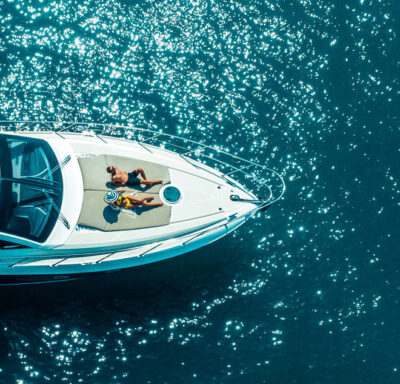1: The Basics of Superyacht Financing
2: Tax Considerations for the Ultra-Rich
3: Creative Approaches to Yacht Financing
4: Navigating the Risks and Rewards
4b. Sample Annual Budget for a 150 ft Superyacht
For many, a superyacht is the ultimate display of success, representing not just wealth but a lifestyle that many aspire to yet few achieve. However, while the allure is evident, what lies beneath this spectacle is a complex world of finance, strategy, and careful planning. Let’s dive into that world with one quick disclaimer. We are yacht enthusiasts, not accountants or attorneys. Please consult an actual professional, not YachtSurf.com before financing a hundred million dollar Superyacht.
1: The Basics of Superyacht Financing
Traditional Methods of Purchase
- Full Cash Purchase: For those with deep pockets, purchasing a superyacht outright is the most straightforward approach. No loans, no interest, just a direct transaction that grants immediate ownership. This method is favored by individuals who wish to avoid the complications of financing or those who view the yacht as an immediate asset.
- Loans: Not every billionaire has liquid assets available for such a hefty purchase. Many turn to yacht financing through established banks or specialized lenders who understand the nuances of the luxury boat market. These institutions offer loans specifically tailored to the needs of superyacht purchasers. Potential owners must, however, be prepared to navigate interest rates, decide on the best loan terms, and determine how much down payment is feasible for their financial situation.
- Leasing Options:
- How a Lease-Purchase Option Works: Think of it as a test drive for the super-rich. A lease-purchase option allows potential owners to lease a yacht with an option to buy it at the end of the lease term. This is particularly useful for those unsure about long-term commitment or those wanting to experience ownership before making the full investment.
- Benefits of Leasing Before Buying: Leasing offers flexibility. Owners can experience the yacht lifestyle without the full commitment. Additionally, some of the lease payments can often be credited towards the eventual purchase price, making it a financially strategic move.
Joint Ownership
- Sharing the Costs – Syndication or Fractional Ownership: Instead of bearing the full brunt of yacht ownership costs, some opt for syndication or fractional ownership. This approach divides the yacht’s ownership among several parties, each holding a “fraction” of the vessel. It’s akin to timeshare properties but on the water.
- Understanding Management and Time Allocation: Fractional ownership is not without its challenges. Decisions need to be made on how the yacht is managed, who bears which costs, and how time aboard the yacht is allocated among owners. Clear agreements and understanding are crucial to prevent disputes and ensure a harmonious shared ownership experience.
2: Tax Considerations for the Ultra-Rich
When it comes to superyachts, the financial intricacies go beyond the initial purchase or loan terms. For the ultra-rich, tax considerations play a significant role in the decision-making process surrounding yacht ownership. Strategic decisions can result in substantial savings and benefits.
Flagging and Registration
- Impact of the Flag State on Tax Obligations: A yacht’s flag state, or the country under which it is registered, determines many of its regulatory and tax obligations. Beyond maritime laws and crewing standards, the flag state can greatly influence the vessel’s tax liabilities, both for sales and annual taxes. The choice of flag state is, therefore, a critical financial decision.
- Popular Tax-Friendly Jurisdictions: Some jurisdictions are popular among yacht owners for their tax advantages. Places like the Cayman Islands, the Isle of Man, and the Marshall Islands offer attractive registration benefits. These jurisdictions may have reduced or no taxes on yachts, making them favored choices for those seeking to minimize tax exposure.
Within the U.S. Florida, Delaware, Alaska, Oregon, and Rhode Island are popular choices. Outside of the U.S. these are usually the top options:
- Cayman Islands: This British Overseas Territory is a significant flagging jurisdiction for yachts, thanks in part to its tax-neutral environment.
- Isle of Man: Offers a VAT-efficient yacht leasing structure, which can significantly reduce the effective rate of VAT on yachts.
- Marshall Islands: As a popular flag of choice, it offers a range of benefits, including no sales or use tax on yachts.
- Malta: Known for its VAT leasing scheme, allowing yacht owners potentially to pay a reduced effective rate of VAT on their yachts.
Leasing Schemes
- Leasing from One’s Own Company: One strategy the wealthy often employ involves creating a company that owns the yacht and then leasing the yacht from that company. This can be a way to reduce Value Added Tax (VAT), especially in regions with high VAT on luxury items. By leasing the yacht from their own company, owners might pay a reduced rate of VAT on lease payments rather than a large VAT bill on an outright purchase.
- Case Study: Mediterranean Yacht Leasing: In the Mediterranean, yacht leasing schemes have gained popularity as a way to mitigate VAT costs. Countries like Malta and Italy have specific provisions that allow for a reduced effective VAT rate on yacht leases. These schemes are based on the presumption that yachts spend a portion of their time outside EU waters, and therefore should not be fully subject to EU VAT.
Chartering the Yacht
- Generating Income to Offset Costs: Chartering is not just for commercial vessels. Many superyacht owners offer their yachts for charter when they are not using them. This can be a significant source of income, helping to offset the costs of maintenance, crew, and other expenses. Superyacht charters can generate six or even seven figures a week in income.
- Potential Tax Benefits and Considerations: Chartering a yacht can come with its own set of tax implications. Revenue generated might be taxable, but owners can often deduct yacht-related expenses. Depending on the jurisdiction, chartering can also affect VAT status, so it’s vital for owners to consult with tax professionals familiar with the complexities of yacht chartering.
Trusts and Corporate Structures
- Establishing a Corporate Entity: Many yacht owners opt to establish a corporate entity to own the yacht. By doing this, they can achieve greater privacy, limit personal liability, and often benefit from tax efficiencies.
- Protecting Assets and Benefiting from Tax Efficiencies: Holding a yacht within a trust or corporate structure can protect the vessel from potential creditors and legal disputes. Additionally, trusts and corporations may offer routes to tax optimization, depending on the jurisdiction and structure chosen.
3: Creative Approaches to Yacht Financing
Beyond the traditional methods, innovative and modern financing strategies have emerged in the superyacht market. These new approaches reflect broader shifts in global finance, technology, and societal trends.
Crowdfunding and Partnerships
- Tapping into the Community – A Modern Approach: At first glance, the idea of crowdfunding a luxury asset like a superyacht might seem far-fetched. However, in an era where community-driven projects can raise millions, even the world of yachts is not immune. Individuals or groups might present a compelling reason for a yacht – perhaps for ecological research or unique travel experiences – and appeal to a wider community to fund it.
- Limitations and Benefits of These Methods:
- Benefits: Crowdfunding can democratize access to luxury experiences, allowing more people to engage with the yachting world. It can also create a sense of community around a shared goal or vision.
- Limitations: Crowdfunding a superyacht might not raise enough funds for the entirety of the costs, and management of the yacht post-purchase could be complex with so many stakeholders.
Sponsorship and Branding
- Turning the Yacht into a Marketing Opportunity: In the age of Instagram and global branding, a superyacht can be more than just a personal luxury vessel – it can be a floating billboard. Owners might strike deals where brands sponsor parts of the yacht, from its sails to its interiors, in exchange for visibility and marketing opportunities.
- Partnerships with Luxury Brands: Imagine a yacht that’s not just fitted with luxury amenities but is an embodiment of a luxury brand. From fashion houses to luxury automobile brands, collaborations can result in unique yacht designs and onboard experiences. This synergy can offset costs and increase the yacht’s prestige and value.
Cryptocurrency and Digital Assets
- The Rise of Blockchain and its Role in Luxury Asset Financing: As cryptocurrencies and blockchain technology continue to shape global finance, they’re making their mark in the world of superyachts too. Some sellers now accept cryptocurrencies as payment, and blockchain technology can also play a role in verifying the authenticity of yachts and their components.
- Pros and Cons of Crypto Transactions for Yachts:
- Pros: Cryptocurrency can facilitate quicker and more seamless large transactions without the need for traditional banking systems. It also caters to a new generation of wealthy individuals who have profited from the crypto boom.
- Cons: Cryptocurrency markets can be volatile, leading to fluctuating yacht prices. Regulatory landscapes are also still evolving, leading to potential legal complexities in crypto-based transactions.
4: Navigating the Risks and Rewards
The Importance of Expert Consultation
- Working with Yacht Brokers: A reputable yacht broker isn’t just a salesperson – they’re a guide through the complex world of yacht purchases. From understanding the market to negotiating prices and ensuring all legalities are in order, a broker can be invaluable in the buying process.
- Financial Advisors and Tax Experts: Given the significant financial implications of buying a superyacht, consultation with financial advisors is crucial. They can offer guidance on financing methods, potential tax benefits, and long-term financial planning. Additionally, tax experts, especially those familiar with international maritime laws, can ensure compliance and help identify tax-saving strategies.
Hidden Costs of Ownership
- Maintenance: A superyacht, with its myriad of systems and luxury amenities, requires regular maintenance to ensure it remains in pristine condition. This can range from routine cleaning to more complex engine overhauls.
- Crew Salaries: A vessel of such grandeur requires a professional crew, including a captain, deckhands, engineers, and hospitality staff. Salaries and the associated costs (like insurance and training) can accumulate substantially over time.
- Insurance: Given the value of the asset, insurance premiums for superyachts can be quite high. It’s essential to have comprehensive coverage, from potential damages and accidents to protection against piracy.
- Planning for Unexpected Expenses: The world of yachts can be unpredictable. From unforeseen repairs to changes in maritime regulations, yacht owners must have a financial cushion to handle unexpected expenses.
Sample Annual Budget for a 150 ft Superyacht
- Crew Salaries:
- Captain: $120,000 – $150,000
- First Mate: $70,000 – $90,000
- Chief Engineer: $70,000 – $90,000
- Deckhands (3): $150,000 ($50,000 each)
- Chief Stewardess: $65,000 – $75,000
- Stewardesses (2): $110,000 ($55,000 each)
- Chef: $70,000 – $90,000
- Total: $655,000 – $765,000
- Fuel: Considering both cruising and generator use: $300,000 – $500,000
- Maintenance:
- Routine: 1-2% of yacht’s value (assuming yacht value at $25 million): $250,000 – $500,000
- Upcoming refit or major repairs can be extra.
- Dockage: Varies widely based on location, but budgeting for premium marinas in the Mediterranean and the Caribbean: $200,000 – $350,000
- Insurance: 0.5 – 1% of the yacht’s value: $125,000 – $250,000
- Management: Yacht management company fees, if utilized: $50,000 – $100,000
- Provisioning & Supplies: Including food, drink, guest amenities: $100,000 – $200,000
- Communications: Satellites, Wi-Fi, and other onboard communication systems: $20,000 – $50,000
- Miscellaneous: Entertainment, toys (like jet skis, inflatable slides, diving equipment), and unexpected costs: $50,000 – $150,000
Total Annual Operating Cost: $1,750,000 – $2,365,000
It’s worth noting that while these figures represent average full-time salaries for the industry, actual compensation can vary based on the yacht’s operational program (private vs. charter), owner’s preferences, the specific responsibilities and experiences of the crew, and other factors.
If a yacht owner opts for part-time or rotational crew, which is less common for core positions on a yacht of this size but possible for some roles, the salary structure and overall budget could differ.
The Long-term Perspective
- Depreciation and Resale Value: Like any vehicle, yachts depreciate over time. However, factors like maintenance, branding partnerships, upgrades, and the reputation of the yacht’s builder can influence its resale value. Owners need to be aware that, despite the initial high cost, the yacht’s value will decrease over time.
- Considering the Yacht as an Investment vs. a Luxury Expense: While some might see potential for profit, especially if the yacht is chartered regularly or benefits from branding partnerships, it’s generally more realistic to view a superyacht as a luxury expense rather than a traditional investment. Unlike real estate or stocks, a yacht’s value doesn’t inherently appreciate, and the ongoing costs can be significant.
Superyacht ownership is a journey that goes beyond the horizon visible from the deck. It’s a complex dance of finance, strategy, and passion. By understanding the risks and rewards, potential owners can ensure their maritime adventure is as smooth as the calmest seas.
Do you have any feedback or additional insights? Please send an email to editor @ yachtsurf.com





